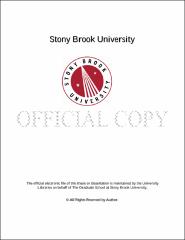| dc.identifier.uri | http://hdl.handle.net/11401/76959 | |
| dc.description.sponsorship | This work is sponsored by the Stony Brook University Graduate School in compliance with the requirements for completion of degree. | en_US |
| dc.format | Monograph | |
| dc.format.medium | Electronic Resource | en_US |
| dc.language.iso | en_US | |
| dc.publisher | The Graduate School, Stony Brook University: Stony Brook, NY. | |
| dc.type | Dissertation | |
| dcterms.abstract | The proteolysis of the beta-amyloid precursor protein (APP) yields Abeta peptides with lengths of 38-42 amino acids by a two-step sequential cleavage involving beta- and gamma-secretase. Abeta40 is the most abundant product, while Abeta42 is the most toxic species to neurons. An increase in the ratio of Abeta42/Abeta40 and an overall increase in secreted Abeta peptides have both been correlated with early-onset familial Alzheimer's disease (FAD). I have focused on two sites where FAD mutations are clustered. The first cluster is in the extracellular domain close to the transmembrane boundary. Within the clusters, the A21G (Flemish), E22Q (Dutch), E22G (Arctic), E22K (Italian), and D23N (Iowa) mutations have very different effects on APP processing. Mutations at Glu22 and Asp23 decrease the level of secretion of the Abeta peptides, while A21G increases total Abeta secretion by more than 3-fold. The second cluster is within the TM domain, below the gamma-cut site that releases Abeta42. A stretch of four beta-branched amino acids when mutated individually increases the Abeta42/Abeta40 ratio. I have focused on the T43I mutation, which increases the Abeta42/Abeta40 ratio by 8-fold. Structural studies have been undertaken in membrane bilayers using NMR and FTIR spectroscopy. These studies have provided several insights into the structure of APP and how structural changes induced by mutation influence APP processing. First, the extracellular sequence from Leu17 to Ala21 has beta-secondary structure, while the transmembrane region is helical starting at Gly29. Second, the A21G mutation reduces the beta-secondary structure near the site of the mutation and increases alpha-helical structure in the region between Gly25 and Gly29. Third, both the wild-type protein and the A21G mutant form transmembrane homodimers mediated by the G33xxxG37 interface. Fourth, the T43I mutation shifts the transmembrane dimer toward the monomeric state. Measurements of Abeta secretion resulting from the A21G and T43I mutations show that both affect the intramembraneous gamma-cleavage, but in very different ways. A21G destabilizes the beta-structure of L17VFF20 sequence, which has previously been suggested as inhibitory to the gamma-secretase. In contrast, T43I destabilizes transmembrane dimerization. As a result, the A21G mutation leads to an increase in total Abeta secretion, while the T43I mutation results in an increase in the Abeta42/Abeta40 ratio. | |
| dcterms.available | 2017-09-20T16:51:32Z | |
| dcterms.contributor | London, Erwin | en_US |
| dcterms.contributor | Smith, Steven O. | en_US |
| dcterms.contributor | Van Nostrand, William | en_US |
| dcterms.contributor | Li, Huilin. | en_US |
| dcterms.creator | Tang, Tzuchun | |
| dcterms.dateAccepted | 2017-09-20T16:51:32Z | |
| dcterms.dateSubmitted | 2017-09-20T16:51:32Z | |
| dcterms.description | Department of Biochemistry and Structural Biology. | en_US |
| dcterms.extent | 193 pg. | en_US |
| dcterms.format | Monograph | |
| dcterms.format | Application/PDF | en_US |
| dcterms.identifier | http://hdl.handle.net/11401/76959 | |
| dcterms.issued | 2015-08-01 | |
| dcterms.language | en_US | |
| dcterms.provenance | Made available in DSpace on 2017-09-20T16:51:32Z (GMT). No. of bitstreams: 1
Tang_grad.sunysb_0771E_11511.pdf: 35951262 bytes, checksum: 1629891edbe08e45b679196f91d1130d (MD5)
Previous issue date: 2013 | en |
| dcterms.publisher | The Graduate School, Stony Brook University: Stony Brook, NY. | |
| dcterms.subject | Biophysics | |
| dcterms.subject | Alzheimer's disease, amyloid precursor protein, Familial mutation, FTIR, membrane protein, solid state NMR | |
| dcterms.title | Structural Changes in the beta-Amyloid Precursor Protein Induced by Familial Mutations | |
| dcterms.type | Dissertation | |

